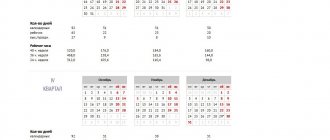Types of piecework wages
Piece wages are a form of remuneration that is introduced with the aim of stimulating workers to produce a larger volume of production in the allotted time. In this case, the main indicator for calculating an employee’s income is the quantity of products produced (services provided, work performed).
We do not recommend establishing piecework payment in industries that require increased concentration of attention from the employee, since the pursuit of increasing the number of products produced can lead to a large number of defects.
The following types of piecework wages are distinguished:
The employer has the right to approve several remuneration systems at one enterprise for each position, department, etc. For example, for the administration - time-based, for the sales department - commission, for the production department - piece-rate bonus. See also “Time-based wage system is.”
Basic prices
Let's consider the question of how to correctly calculate piecework wages and prices for it. The piece rate can be calculated by a rater based on an analysis of the work of an employee or the team as a whole over several months.
The instructions for calculating the piece rate are as follows:
- Conduct a performance analysis for three, six and twelve months. To do this, all products produced during the analysis period are added up and divided by the number of working days in the billing period. This gives the average of the products produced per day. The resulting value must also be divided by the number of working hours, to obtain the number of products produced per hour.
- We provide pricing for manufactured products. To do this, we determine the average daily salary of an employee. To make this calculation, we add up all the employee’s earnings for 12 months, divide them by 12 and by 29.4 (the average number of working days in a month). We get paid in one day.
- Let's divide the average daily wage by the number of products produced by a worker in one day. We get the cost of one part.
- To determine average piece rates, we add up the number of products produced for three, six, twelve months of all employees and divide by the number of days during which the products were produced.
- We calculate average earnings for the analysis period.
- We divide the average daily salary by the number of products produced per day. We thus obtain the average piece rate.
Direct piecework wage system
It is approved, as a rule, by production employees, for whom work standards can be set. For example, time or production standards.
In this case, earnings are calculated based on the number of products manufactured and the prices set by the employer.
The formula for calculating income is as follows:
The piece rate per unit of production can be determined in several ways, for example:
- multiplying the hourly (daily) tariff rate by the hourly (daily) time standard;
- dividing the hourly (daily) tariff rate by the hourly (daily) time standard.
Example 1
Masterok LLC has established a piecework wage system for workshop employees. For the production of one part, a rate of 1,000 rubles is provided. An employee produced 44 parts in September 2021. His earnings amounted to 44,000 rubles. (44 units × 1,000 rub.)
Such a system encourages the employee to increase the volume of output, but he is not interested in the quality of the parts produced. To motivate employees to produce products without defects, employers are introducing piecework-bonus wages.
Piece-progressive wage system
It is used to encourage employees to produce as many products as possible in excess of production standards. Products manufactured by an employee in excess of production standards are paid at increased piece rates.
It is advisable to use this system when you need to quickly increase production volumes. Therefore, it is used quite rarely and for a short time (usually no more than 6 months).
With such a remuneration system, additional bonuses may be provided.
Salary under the piecework-progressive system is calculated according to the formula:
Earnings for products produced within the norm are calculated by multiplying the piece rate within the norm by the number of products manufactured within the norm. And the salary for products in excess of the norm is by multiplying the increased price by the number of products produced in excess of the norm.
Example 3
Let's change the conditions of example 1 and assume that Masterok LLC has installed a piece-rate progressive wage system. The norm is 35 parts per month. The price for each part is RUB 1,000. For exceeding the norm - 1,300 rubles. The accountant calculated the employee’s earnings in several steps:
- income within normal limits - 35,000 rubles. (35 units × 1,000 rub.);
- salary above the norm - 11,700 rubles. ((44 units - 35 units) × 1,300 rub.);
- Semenov’s total income for September is 46,700 rubles. (35,000 + 11,700).
Indirect piecework wage system
This system is used to pay support staff, for example, workers who set up equipment. Their income depends on the output of key workers. This system is used to encourage support staff to provide better services to key workers.
The law does not provide for a single formula for calculating wages under an indirect piecework wage system. The employer can develop and approve its own options.
We'll look at a few possible examples.
At indirect piece rates
The formula for calculation will be as follows:
Example 4
A. M. Grigoriev works at Masterok LLC, who prepares blanks for A. Yu. Semenov for processing manufactured parts. Grigoriev’s daily rate is 1,400 rubles. Semenov’s monthly production rate is 35 parts, but in fact Semenov produced 44 parts.
Grigoriev’s indirect piece rate per shift: 1,400 rubles. / 35 children = 40 rub.
Since Semenov exceeded the plan, Grigoriev’s daily earnings increased:
40 × 44 children. = 1,760 rub.
Grigoriev worked 22 shifts in September. His income was 38,720 rubles. (22 × 1,760 rub.)
Using the average compliance rate
The formula in this case:
An example of salary calculation for a time-based bonus system
The Inspiration SPA salon has a time-based bonus wage system. The bonus regulations state that all employees are entitled to a 25% increase in salary if the salon's total monthly revenue reaches or exceeds a certain figure. Master massage therapist with a monthly salary of 8 thousand rubles. out of 25 working days in a month, he worked 22. The profit of the salon in the accounting month reached good levels, giving grounds for bonuses. Let's calculate how much a master massage therapist will receive this month.
This is important to know: KPI system: compensation based on KPI
Now let’s determine the amount of the bonus due, find 25% of the salary (note, not from the salary, but from the amount earned this month): 7040 x 25 / 100 = 1760 rubles.
Chord system of remuneration
As a rule, it is installed for individual teams if it is necessary to reduce the time required to complete the work. Employees are paid for performing a certain set (volume) of work according to a unit assignment, and not individual operations or types of work.
The entire list of works included in the chord task, their volume, time standards (production), prices, total cost and deadline for completing all work are established in advance. Payment is distributed among employees, for example, as follows: based on the time worked by each of them, in accordance with the labor participation rate.
The lump sum wage system can be used for construction work, emergency response, and repair of machinery and equipment.
Example 6
The team consists of 5 people. A contract assignment for the construction of utility premises for Sfera LLC was received in the amount of RUB 250,000. The brigade completed the task in a month. The amount of earnings was distributed in proportion to the time worked:
| Workers | Time worked | Amount to be received (RUB) | Calculation |
| 1 employee | 23 days | 59 895,83 | 250 000 / 96 × 23 |
| 2 employee | 20 days | 52 083,33 | 250 000 / 96 × 20 |
| 3 employee | 25 days | 65 104,17 | 250 000 / 96 × 25 |
| 4 employee | 18 days | 46 875,00 | 250 000 / 96 × 18 |
| 5 employee | 10 days | 26 041,67 | 250 000 / 96 × 10 |
| Total | 96 days | 250 000 |
Employees need to be paid wages at least every half month (Article 136 of the Labor Code of the Russian Federation). It is prohibited to pay the entire salary amount in one lump sum after completing the work.
With such a system, additional bonuses may be provided. The bonus is paid in accordance with the employer's bonus system (for example, for reducing the deadline for completing a task, subject to high-quality work).
Advantages and disadvantages
None of the material motivation systems used today is ideal and, in addition to positive qualities and results, creates additional negative effects that must be taken into account when using it.
The pros and cons of the piecework-bonus system are presented below in table form.
| Advantages | Flaws |
| 1. High material interest of the employee in the results of work, enhanced by the presence of additional bonuses | 1. In the presence of a complex, branched system of bonuses, it creates the need for rather complex and labor-intensive calculations. |
| 2. Significant reduction in the need for direct control over the employee’s labor behavior | 2. The introduction of the piecework component requires significant preparatory work |
| 3. The piece-rate payment system generates variable company costs, which increase or decrease depending on the volume of activity, which has a positive effect on profit levels | 3. It is advisable to implement only if there is a relatively stable volume of work in the company. |
| 4. Allows you to influence additional parameters of an employee’s work, in addition to pure labor productivity | 4. The premium component requires additional financial costs |
Examples of professions
The use of the piecework part of the piecework-bonus system largely limits the scope of its application. As a rule, this is an activity associated with performing work manually or using mechanization tools with relatively stable volumes of detail.
At the same time, the results of employees’ work should be easily measurable and it can have a direct impact on them. In particular, this is work related to the manufacture of machine parts and mechanisms, in particular, turners, milling operators, machine operators, mechanics, and assemblers.
In addition, a number of positions related to warehouse work also allow the use of a piecework-bonus system: storekeepers, loaders, forklift and stacker drivers.
In part, a piece-rate bonus system can also be considered for the commercial department involved in sales, but you need to understand that in this case it is difficult to ensure the stability of orders, and, accordingly, the employee’s earnings. Consequently, if the market situation worsens, this system will not work in this area.
It is not advisable to use this system in the field of office work, since it is focused on maintaining processes and is poorly linked to the results of the company.
For support workers who indirectly influence the production process (repairmen, adjusters), it is more convenient to use an indirect piecework system.
Commission pay
Such a remuneration system is usually used in relation to workers involved in the sale of goods and services: sales managers, store clerks, advertising and marketing specialists, in order to encourage them to increase sales volume, sell products (work, services) to the maximum volumes.
In a commission system of remuneration, earnings are determined as a percentage of sales or revenue received by the organization. At the same time, regardless of the volume of sales or revenue, the monthly earnings of an employee who has fully worked the standard working hours for a given period cannot be lower than the minimum wage (Part 3 of Article 133 of the Labor Code of the Russian Federation).
We remind you: from January 1, 2019, the minimum wage is 11,280 rubles. And from 01/01/2020 - 12,130 rubles. Regions have the right to set their own minimum wage, but it cannot be lower than the values given above.
Salary can be calculated in various ways - it can be:
- fixed percentage of revenue;
- salary with additional payment in the form of a fixed percentage of the amount of revenue;
- a fixed percentage of the difference between the sales price and the cost of products (works, services).
Example 7
Sellers at the Severny store are paid 1% of their monthly revenue. In September, the revenue amounted to 2 million rubles. The salary of each seller was 20,000 rubles. (RUB 2,000,000 × 1%).
Documentation of wages under the piecework system
To record production and volumes of work performed, you can use unified forms:
- piecework work order,
- statement of work performed,
- route sheet,
- and so on.
The employer has the right to independently develop accounting forms. At the same time, it is important to comply with the requirements for primary documents approved by Art. 9 of the Law of December 6, 2011 No. 402-FZ “On Accounting”. The primary must include:
- document's name,
- Date of preparation,
- company name (full name, individual entrepreneur),
- salary calculation,
- sum,
- responsible persons of the organization,
- signatures of responsible persons.
All documents you use must be attached to the enterprise's accounting policies.
Content
- What is piecework wages?
- Concepts inextricably linked with the word “piecework”
- Calculation of piecework wages
- Types of piecework wages for workers
- The procedure for transferring to piecework wages
- Advantages and disadvantages of piecework wages
One of the most important aspects of organizing work activities in a company is the choice of the form of monetary remuneration for employees. We are most familiar with the time-based form, when salaries are calculated depending on the salary and the number of days worked. However, such a scheme is not suitable for many types of activities where it is extremely important for the employer to motivate the employee to increase productivity, and also where it is possible to keep quantitative records of the work performed. Then another common form is used - piecework wages.







